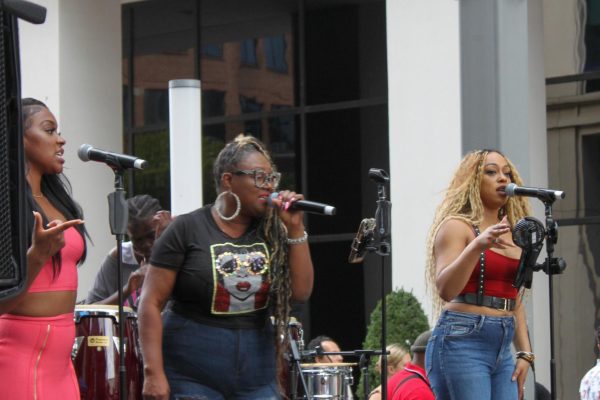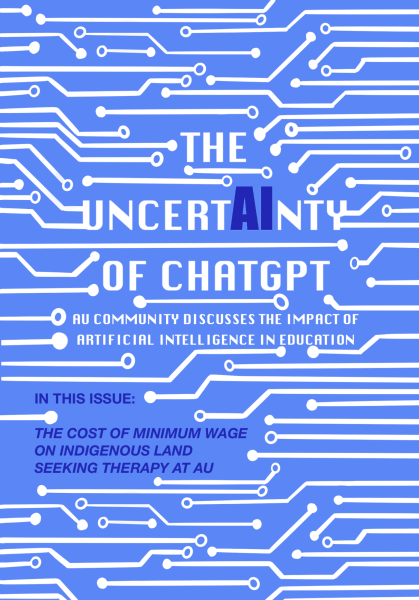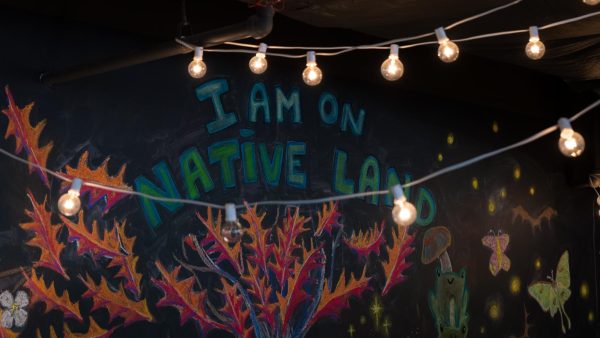Safety at a crossroads
DC’s work to improve traffic safety, and how advocates are pushing for change
Washington, D.C., residents will receive more traffic safety protections in the coming year as the District moves to further the Vision Zero initiative; however, traffic crashes are still occurring.
The Vision Zero Initiative, which was implemented in 2015, aims to decrease traffic deaths to zero by 2024, according to the initiative’s website. The Metropolitan Police Department, MPD, said the District recorded over 30 traffic fatalities each year over the past three years.
In 2022, the District experienced 35 traffic-related fatalities and over 5,000 injuries from traffic crashes, according to MPD data. A majority of these crashes took place in Wards 7 and 8. About 54% of the victims were pedestrians, according to the Vision Zero website. The initiative’s website said four of the city’s traffic fatalities occurred in Ward 3, with an additional 228 injuries.
A Vision Zero Division within the District Department of Transportation, DDOT, was first created in 2019. It was not funded until September 2020 when the City Council passed the Vision Zero Omnibus Bill that proposed stricter traffic laws and modified road infrastructure, according to the recent audit of the program. The Office of the District of Columbia Auditor, ODCA, released a report on the progress made by DDOT on their Vision Zero goals in March.
The ODCA recommended increasing traffic safety, including improving the current Traffic Safety Investigation request system, increasing transparency regarding the initiative projects and further incorporating equity commitments.
“While District leaders made a public commitment to Vision Zero, implementation was delayed by failure to establish the bureaucratic infrastructure within DDOT and failure to fully fund the Vision Zero Omnibus Amendment Act,” according to the report. “DDOT used resources to conduct proactive studies but did not systematically track these recommendations and incorporate them into a robust data framework.”
The DDOT received around $192 million in the 2023 budget, according to the Office of the Chief Financial Officer. Mayor Muriel Bowser said in the October 2022 Vision Zero update that funds have been allocated for safety improvements at 15 of the most dangerous intersections. Mayor Bowser also said there are scheduled improvements for the school crossing guard program.
Members of the Washington community are working toward greater traffic safety by advocating for better legislation, such as ANC Commissioner Robb Dooling, who uses he/they pronouns, and DC Families for Safe Streets, or DC-FFSS.
Dooling said he ran on a platform of safe streets. According to Dooling’s website, he has continued to push for more safety measures throughout his previous role on Washington’s Multimodal Accessibility Advisory Committee.
“They have a volunteer organization to continue to advise the government and meet with the Department of Transportation, and get the disabled communities’ feedback and things like that,” Dooling said. “Like, for example, the bus lane. How can that be more accessible? How can it be easier for wheelchair users?”
The DC-FFSS website said the organization advocates for traffic legislation and better implementation of the city’s Vision Zero initiative. In February, three DC-FFSS members testified at the DDOT Performance Oversight hearing, according to the website.
“We seek to transform our grief by telling our personal stories of loss to affect change. We know, and have proof that people who walk, roll, bike and drive can safely co-exist on our streets,” according to the DC-FFSS website.
One of the DC-FFSS members who testified at the DDOT hearing was Jessica Hart, whose 5-year-old daughter was killed while biking across a crosswalk in 2021.
“We have shared our heart wrenching stories,” Hart said in her testimony. “We’ve learned traffic engineering on the fly. We’ve attended ANC and Council meetings. It’s not enough. My testimony today highlights the burden we put on residents to identify the changes needed, and shows how DDOT prioritizes moving cars over human safety.”
The data-driven Vision Zero program analyzes the most dangerous intersections and publishes data on a new initiative website showing where safety improvements have been made, according to the DDOT website. These improvements include crosswalk visibility enhancements, left-turn traffic calming initiatives involving traffic pylons on crosswalks and a 20-mile-per-hour default speed limit on local streets, according to the initiative website.
MPD data shows that in the eight years since the Vision Zero goal was implemented, traffic fatalities have increased. There were 40 traffic fatalities in 2021–the most since 2007.
Dooling said that the Vision Zero idea first started in Europe with the goal of achieving zero traffic deaths. He said the city government did not make a big push for the idea.
“How do we measure success?” Dooling said. “How many people died in traffic, car accidents, kids who died while walking to school?”
In October 2021, a father and his two daughters suffered significant injuries after being hit by a car on National Walk to School Day, according to the Washington Post, which reported on the incident at the time.
“The number of deaths in D.C. is going up,” Dooling said. “But the good news, in 2022 it went down a little bit, but most of the years since 2014, it’s gone up. So we have succeeded a teeny tiny bit, but it hasn’t gone down that much.”
Mayor Bowser said that she admits the goal of zero traffic deaths is ambitious, and she is implementing changes, according to her 2022 Vision Zero update.
In November 2022, the City Council passed the Safe Streets Amendment Act and the Safe Streets for Students Amendment Act. According to the legislation, these laws will prohibit drivers from turning right at red lights by 2025 and increase the size of school zones.
The laws also establish an Office of Safe Passage overseen by the mayor’s office to help protect students and make raised crosswalks the standard for any new road construction.
Senior Kiernan Lewman said she knows traffic safety policies have been implemented, but is still concerned.
“Compared to other U.S. cities, D.C. has crosswalks with not just red and white indicators to walk but also sounds alerting pedestrians that the walk sign is on,” Lewman said. “One negative thing: I’ve seen cars actually hit, at a slow speed, pedestrians walking across the street because they get the green arrow to turn at the same time that pedestrians get the white walk signal to walk.”
School of International Service Professor Jesse Ribot said he rides his bike to campus most days. He said he has concerns about a specific part of his commute.
“The most dangerous place near American University is descending down Massachusetts Avenue from the circle,” Ribot said. “I go down that avenue and I turn left onto Macomb Street. That left turn is totally horribly dangerous. There is not a left turn lane.”
Ribot said there is nowhere to pull over to the right, which could create a dangerous situation during his commute.
“There’s no ramp wide enough to go up onto the sidewalk in a safe way,” Ribot said. “There needs to be some kind of infrastructure put in at that corner to make it safe for bikes because, at the moment, every time I stop there, I feel like I’m gonna get run over.”
Junior Lauren Giddings, who uses she/they pronouns, said Tenleytown is much safer in terms of traffic and pedestrian safety than the rest of the city. However, they said the two traffic circles in Tenleytown are dangerous.
“No one really knows how Ward Circle functions unless they’re previously familiar with it, which most drivers aren’t,” Giddings said. “It creates an unsafe environment for both drivers operating cars in the circle and the high amount of pedestrians in the area commuting to campus.”
While the streets around AU are safer than many other areas of Washington, according to the city-run Crash Dashboard, first-year student Abigail Ogden said that students can still help to increase traffic safety.
“Jaywalking is such a common practice in D.C., especially with college students, but this is really compounded by the fact that cars in D.C. really don’t have any concern for pedestrians,” Ogden said. She said she saw a car hit someone jaywalking near campus.
“Obviously there’s an issue when pedestrians are crossing when they shouldn’t, but there should really be a crackdown on speeding and running lights because it simply isn’t safe with so many pedestrians in a city,” Ogden said.
Assistant Vice President for Community and Internal Communication at AU Elizabeth Deal said that the university has taken steps to increase traffic safety in the area.
“The goal of AU’s Transportation Demand Management program is to reduce the number of single-occupancy vehicles traveling to campus,” Deal said.
Deal said the university works toward this goal by collaborating with neighbors, the District and campus partners to offer different sustainable transportation alternatives.
Deal said AU partnered with Spin, an electric bicycle-sharing and electric scooter-sharing company, as the official scooter brand for the university and has worked to make this mode of transportation as safe as possible.
“We’ve worked with both Spin and the other area scooter companies to geofence the campus, creating slow zones and marked corrals for scooter parking with safety being at the forefront of these efforts,” Deal said.
AU and Spin have worked together to ensure compliance with the university’s Good Neighbor Guidelines.
“Part of this scooter partnership stipulates that AU be made aware of any accidents or safety incidents on or around campus and/or involving AU community members,” Deal said.
However, Ribot said that increasing the number of electric bikes and scooters might be unsafe.
“I think the scooters are super dangerous,” Ribot said. “Anyone who rides one is stupid if they’re not using a helmet, I would say the same for bike riders.”
Ribot said that people riding scooters are often unaware of the dangers.
“They act like they own the road,” Ribot said.“They don’t. They act like they’re invincible. They’re not.”
Ribot said that motorized bikes and motorcycles riding in bike lanes also create problems.
“Frankly, it should be for people on human-powered bikes, and if they’re on motor bikes, they should go slower, only because they pass and surprise people way too close, way too quickly,” Ribot said.
One way that the AU community can improve its attitude toward traffic safety is by using proper terminology, according to DC-FFSS. For example, the organization asks people to pledge to use the word “crash” rather than “accident” because traffic crashes are problems that can be fixed by changing street designs and driving practices, according to the DC-FFSS website.
As the City Council and Mayor Bowser continue to push for their Vision Zero goal, Dooling said there are other steps that individuals can take to get involved in their communities.
“Attend your ANC meetings,” Dooling said. “One more person to push for walking-friendly streets, I think that will make a difference.”
This article is a part of AWOL’s 32nd Magazine edition

Elizabeth Scott (she/her) is a Senior studying International Relations. She loves listening to (almost) any kind of music and is a huge Olympic fan....












